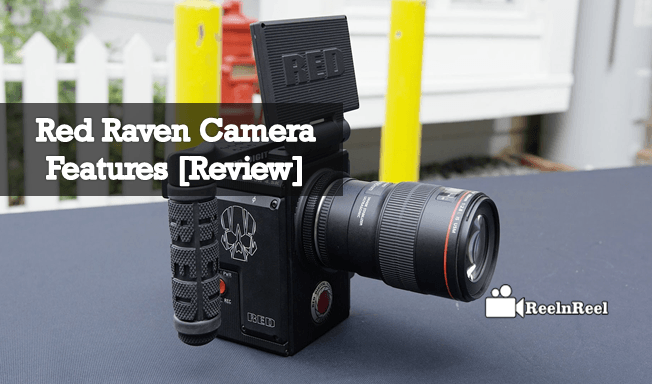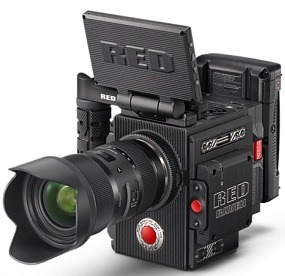`Red Raven‘ is a complete camera system released by RED. Unlike Brain Alone, which only has a sensor and processor, Raven does not require any additional accessories, as it is a complete camera system. This is priced below $ 10,000.
Features of the RED Raven include the 4.5K Red Dragon sensor, which can shoot up to 120 fps in 4.5K or 240 fps in 2K. It weighs 3.5 lbs. This camera is capable of capturing both motion and stills in high resolution.
Like all other RED cameras designed for excellent image quality and modularity, the Red Raven is also a full-fledged professional camera that is small, lightweight, and suitable for gimbal and drone applications.
All controls of the Red Raven can be operated via the touchscreen. While most cameras require significant adjustments for exposure, which can be imperfect, the Red Raven offers a tremendous dynamic range. Let’s take a look at the specifications of the Red Raven now.
RED dragon 9.9 CMOS sensor
4608 x 2160 pixels
RED Raven is capable of recording in REDCODE Raw. REDCODE Raw file format is also known as R3D.
The camera offers flexibility and freedom to record simultaneously in various formats, including R3D, Apple ProRes, and Avid DNxHD.
It weighs 3.5 lbs.
In 2K, it shoots up to 300 fps
150fps in 4K
120fps in 4.5K
- Shooting while on the move
- Detachable handles and lenses
- A variety of shooting modes
- Small and portable
- Easy to use
- Great for travel photography
- Long-lasting battery
- Manual Auto focus
- Fully Weatherproof
- Compact Design
- 6 million pixel sensor or lower
- shoe-mount style
- APS-C sensor
- pixels per inch (PPI) >10 Megapixels
- Fast Shutter Speed
- Expensive Lens
- High Resolution
- 720p HD Video Recording
- 1/2.3″ High-quality Sensor
- Wind & Water Resistant
- A wide-angle lens lets more light in
- The smaller sensor means more images per second
- 30+ megapixels of resolution
- Longer battery life
- Rechargeable battery pack for portability
- Large, high-resolution LCD screen to review images and make adjustments
- Usability options, such as Live View, allow the photographer to see the exact frame before shooting
- Time lapse feature with the ability for a photographer to capture an interval between shots – 10 seconds to 23 hours
- Perfect mirrorless camera for students
- Great for kids and pets
- Affordable beginners camera
- Built For The Future
- Complete Range with a Wide Lens Support
- Intuitive and Simple to Use Cameras
- Top-of-the-Line Lenses for Sharp Shots
- Focus peaking
- Panorama stitching mode
- Auto level recording
- Intelligent auto mode
- MTS format videos
- Compact Body for Travel
- Mid-Range Zoom Lens
- HDR Capabilities
- Variable Shutter Speed
- 3:2 Aspect Ratio
- Mirrorless Camera
- Back SD card slot
- LED Display
- External Flash Shoe
- Focusing Modes
RED Raven can capture high-resolution motion. Since its weight is very low, it can be used with drones, and video can be shot by hand. Although the camera is small, it produces high-quality footage suitable for cinema. The dynamic range enables the user to capture HDR content right out of the box.
Conclusion
The RED Raven stands out as a powerful, high-quality cinema camera in a surprisingly compact form factor. It delivers cinematic image quality, boasting an excellent dynamic range, high frame rates, and flexibility for gimbals and drones. However, its allure comes with caveats:
-
Total System Cost: Although the base brain is reasonably priced, the real-world cost increases significantly when accounting for Mini-Mag storage, batteries, mounts, and the touchscreen, often doubling the investment.
-
Ecosystem Lock-In: RED’s proprietary accessories—media, battery systems, and touchscreens—offer seamless integration and performance but may discourage users who prefer third-party compatibility.
-
Usability Trade-offs: The touchscreen interface, while functional, lacks buttons or external controls. Sunlight glare and the absence of internal ND filters or XLR audio inputs may pose practical challenges in certain shooting situations.
Ultimately, the Raven is ideal for filmmakers seeking RED-level quality in a lightweight package, especially for commercial, documentary, or slow-motion projects. However, for cost-conscious indie users or general multimedia work, similar image capabilities may be found in more affordable and flexible alternatives that do not require a deep investment in RED’s ecosystem.
Red Raven Camera Features [Review]: FAQs
What Is the RED RAVEN Camera Designed For?
The RED RAVEN is designed as a compact, entry-level cinema camera offering 4.5K resolution and high frame rate recording, ideal for indie filmmakers, drone operators, and commercial videographers.
What Sensor Does the RED RAVEN Use?
It uses the RED DRAGON 4.5K sensor, which provides up to 16.5+ stops of dynamic range and excellent color fidelity.
What Are the Maximum Frame Rates Supported?
The camera can shoot at up to 120 fps in 4.5K and up to 240 fps in 2K, making it suitable for cinematic slow-motion applications.
Is the RED RAVEN Suitable for Handheld or Drone Use?
Yes. Weighing in at approximately 3.5 pounds, the RED RAVEN is optimized for use with handheld rigs, gimbals, and aerial drones.
What Are the Common RED RAVEN Camera Kits Available?
There are typically three kits: the Brain-only version ($5,950), the Jetpack kit ($9,750), and the Base I/O kit (~$9,950), each offering different power and accessory options.
Can I Use Third-Party Accessories with the RED RAVEN?
Limited support exists for third-party accessories. RED uses proprietary Mini-Mags, battery plates, and touchscreen monitors, which may restrict compatibility.
Does the RED RAVEN Support ProRes or DNxHD?
Yes. It supports Apple ProRes and Avid DNxHD in addition to REDCODE RAW, offering flexibility in post-production workflows.
What Is the Image Quality Like on the RED RAVEN?
The image quality is cinematic, with rich colors and strong low-light performance. It’s praised for retaining detail and dynamic range, especially in HDR scenes.
What Are the Downsides of Using the RED RAVEN?
Drawbacks include the absence of internal ND filters, touchscreen-only control, limited audio input options, and a reliance on expensive, proprietary media and accessories.
How Much Does a Fully Functional RED RAVEN Rig Cost?
While the base camera is under $6,000, a full production-ready setup (including storage, power, lens, and monitoring) typically exceeds $10,000.
Is the RED RAVEN Still in Production?
No. RED has discontinued the RAVEN, but it is still widely available on the used market and supported with firmware and ecosystem accessories.
What Types of Projects Is the RED RAVEN Best Suited For?
It excels in music videos, commercials, high-frame-rate shorts, and documentary work that requires a lightweight, mobile cinema camera.
How Does the RED RAVEN Compare to the URSA Mini or BMPCC 6K?
The RED RAVEN delivers superior RAW workflows and higher frame rates but is significantly more expensive and less flexible than options like the URSA Mini or Blackmagic Pocket Cinema Camera 6K.
Can I Use Canon EF Lenses on the RED RAVEN?
Yes. The RED RAVEN features a native Canon EF mount, enabling users to work with a wide range of Canon-compatible lenses.
What Media Format Does the RED RAVEN Use?
It uses RED Mini-Mag SSDs, which are fast and reliable but also expensive compared to standard SD or CFast cards.
What Post-Production Software Supports RED RAVEN Footage?
Editing tools like Adobe Premiere Pro, DaVinci Resolve, and Final Cut Pro support REDCODE RAW. RED provides its own SDK and REDCINE-X Pro software as well.
Does the RED RAVEN Have Built-In Audio Inputs?
No XLR inputs are included. You need external audio interfaces or modules for professional audio capture.
Is It Beginner-Friendly?
Not entirely. The RED RAVEN is best suited for experienced shooters familiar with cinema camera workflows and post-production pipelines.
Can I Still Get Support or Repairs for the RED RAVEN?
Yes. RED continues to support RAVEN users with firmware updates and repair services, though parts availability may decrease over time.
Why Did RED Discontinue the RAVEN?
The RAVEN was phased out to make way for newer models, such as the KOMODO and V-RAPTOR, which offer improved technology in even smaller form factors.






